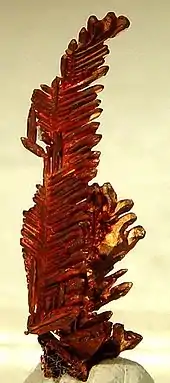| Owner | Hudson Institute of Mineralogy, Keswick, Virginia |
|---|---|
| Created by | Jolyon Ralph, et al. |
| Industry | Mineralogy |
| URL | www |
| Commercial | No |
| Launched | 10 October 2000 |
| OCLC number | 643335336 |

Mindat.org is a non-commercial interactive online database covering minerals across the world. Originally created by Jolyon Ralph as a private project in 1993, it was launched as a community-editable website in October 2000. As of 2023 it is operated by the Hudson Institute of Mineralogy.
History
Mindat was started in 1993 as a personal database project by Jolyon Ralph. He then developed further versions as a Microsoft Windows application before launching a community-editable database website on 10 October 2000.[1]
After further development taking to the Internet stage, Mindat.org became an outreach program of the Hudson Institute of Mineralogy,[2] a 501(c)(3) not-for-profit educational foundation incorporated in the state of New York.[3][4] To address the increasing open data needs from individual researchers and organizations, as of 2021 Mindat.org has started to build and maintain an open data API for data query and access, and the efforts have received support from the National Science Foundation.[5][6]
Description
Mindat claims to be the largest mineral database and mineralogical reference website on the Internet.[7][2] It is crowd-sourced and also expert-reviewed and curated for data quality. The database is used by professional mineralogists, geologists, and amateur mineral collectors alike, and is referenced in many publications.[8][9][10]
The database covers a variety of topics: scientific articles, field trip reports, mining history, advice for collectors, book reviews,[2] mineral entries, localities, and photographs. Much of the information is from published literature, but registered editors may add and revise information and references.[8] Editors are vetted for their expertise, in order to ensure accuracy. References have to be provided in the proper format, and editors own the copyright of data that they have contributed. The data is organized into mineral and locality pages, with links that allow for easy navigation among the pages.[2]
The pages about minerals include individual minerals and rocks. Naming conventions adhere to the various standards and definitions as published by the International Mineralogical Association, the British Geological Survey, and the Meteoritical Society.
It interfaces directly with the Mineral Evolution Database (MED), and is an important source for scientific research. Many studies have used Mindat for locality information when building knowledge about diversity and distribution of minerals.[8][11]
As of 2021, it included:[8]
- Around 300,000 mineral localities
- Over 1.2m mineral-locality pairs
- Nearly a million photographs
- Information on Apollo lunar samples and meteorites
Recognition
Jolyon Ralph was awarded the Mineralogical Society of America's Distinguished Public Service Medal in 2011 for his work on Mindat.org.[1][12]
References
- 1 2 "The history of mindat.org". mindat.org. 10 October 2000. Retrieved 4 February 2023.
- 1 2 3 4 Lanteri, Sabine (14 January 2022). "mindat.org – A Minerals Database". Inside Science Resources. Retrieved 4 February 2023.
- ↑ "The Hudson Institute of Mineralogy dba mindat.org". The Hudson Institute of Mineralogy. 4 February 2023. Retrieved 4 February 2023.
- ↑ Mindat.org Database - Potomac State College library guide
- ↑ "OpenMindat - Open Access and Interoperable Mineralogy Data to Broaden Community Access and Advance Geoscience Research". National Science Foundation. 1 September 2021. Retrieved 6 February 2023.
- ↑ Ma, Xiaogang; Ralph, Jolyon; et al. (29 May 2023). "OpenMindat: Open and FAIR mineralogy data from the Mindat database". Geoscience Data Journal. Wiley. doi:10.1002/gdj3.204. ISSN 2049-6060.
- ↑ "Mindat.org". The Massachusetts Geological Survey. Retrieved 4 February 2023.
- 1 2 3 4 Daniel, I.; Zahirovic, S.; Bower, D.J.; Ionescu, A.; Pistone, M.; Mikhail, S.; Cardace, D. (2021). Deep Carbon Science. Frontiers Research Topics. Frontiers Media SA. p. 219. ISBN 978-2-88966-328-6. Retrieved 4 February 2023.
- ↑ Voncken, J.H.L. (2015). The Rare Earth Elements: An Introduction. SpringerBriefs in Earth Sciences. Springer International Publishing. p. 50. ISBN 978-3-319-26809-5. Retrieved 4 February 2023.
- ↑ Sagar, B.S.D.; Cheng, Q.; Agterberg, F. (2018). Handbook of Mathematical Geosciences: Fifty Years of IAMG. Springer International Publishing. p. 408. ISBN 978-3-319-78999-6. Retrieved 4 February 2023.
- ↑ "Abellaite". Mineral Evolution Database. Retrieved 4 February 2023.
- ↑ "Mineralogical Society of America". Archived from the original on 18 January 2022. Retrieved 4 March 2013.
External links
- Official website
- Mindat.org - 10 years online today (archived copy)
- Gemdat.org a related website